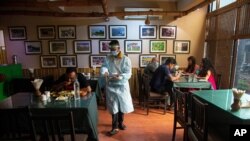As in other countries, India’s hospitality industry is among the worst hit sectors by the COVID-19 pandemic. Cautiously however some restaurants are reopening, prepped up to navigate a post-COVID-19 world with new norms. And although the Indian capital is one of the cities hit hard by the pandemic, four months on people are ready to step out, bringing some hope to an industry that has cost millions their jobs and where many are still shuttered.
Temperature checks, menus and orders being placed on apps, waiters with face shields and masks -- dining out is a whole new experience in the Indian capital.
As restaurants reopen, customers are arriving to savor a sense of normalcy as COVID-19 cases begin to climb down in a city that has been cloistered indoors.
Some have come for a celebration, others with their families.
“I know how I have survived for four months in lockdown so I am eagerly waiting for my food right now," New Delhi resident Neha Yadav said.
Restaurateurs are optimistic that in a world overtaken by screens, business will eventually bounce back.
“Restaurants are the last bastions of hope for offline social human engagement. Everything can go virtual in this world but restaurants and bars can never go virtual. People always want to meet each other; people want to celebrate,” Zorawar Kalra, Managing Director of Massive Restaurants, said.
They are wooing back customers promising contactless dining, vacant tables to ensure social distancing and safe, sanitized kitchens. But it is still a long haul for an industry that has witnessed massive job losses among the seven million people it employed.
This restaurant is one of just two opened by Priyank Sukhija out of the 25 that he owns in India.
“Out of the 1,200 people I employ, each restaurant used to have about 70 to 80 people. Right now this restaurant is operational with 14 people and the second one has 12 people. So I am down to 28 people employing currently,” Sukhija said.
In a city where dining out cornered the highest spending among entertainment options, people are supporting their fight for survival.
“We have to anyhow deal with it, we cannot just sit back at home and let the economy die” Yadav said.
That is giving hope to the industry even as the pandemic remains a concern.
“They want to start living and accepting the virus as part of their life," Sukhija said.





